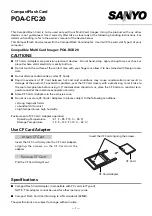
71
If an alarm rings out, the administrator must read the error message on the terminal or the
PAC Management Software screen to determine what has triggered the alarm, and then
take appropriate actions to rectify the problem. The alarm can be turned off using the
mute button on the front panel and the Alarm beep pattern is described in the
Troubleshooting Guide included in the CD-ROM.
NOTE
When temperature exceeds a preset threshold, the controller’s charger circuits will
stop charging. You will then receive a message that reads “Thermal Shutdown/Enter
Sleep Mode.” When the temperature falls back within normal range, the
supercapacitor will resume charging.
I
2
C
The operating status of PSU and cooling fan modules are collected through an I2C serial
bus. If either of those modules fails, the failure will be detected and you will be notified
through the same methods as in the audible alarms.
System Maintenance
WARNING
Do not remove a failed component from the system until you have a replacement on
hand. If you remove a failed component without immediate replacement, it will disrupt
the internal airflow.
Qualified engineers who are familiar with the system should be the only ones who
make component replacements.
When inserting a removable module, do not use excessive force. Forcing or
slamming a module can damage the connector pins either on the module itself or on
the backplane.
The following components can be replaced:
Controller module (please refer to Replacing the Controller Module)
Memory module (please refer to Replacing Memory Module(s))
CBM module (please refer to Replacing the Cache Backup Module (CBM))
Host board (please refer to Replacing the Controller Host Board)
PSU module (please refer to Replacing the Power Supply Module)
Hard drive (please refer to Replacing the Hard Disk Drive)
Restoring Default System Settings
NOTE
Restoring default settings is a last-resort function. All configurations, such as
parameters and host LUN mappings, will be erased.
















































